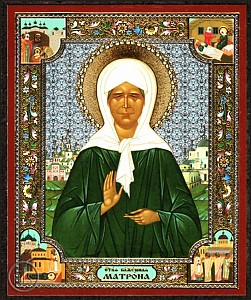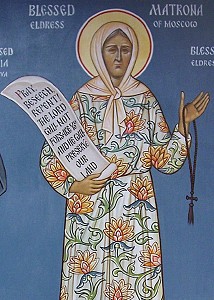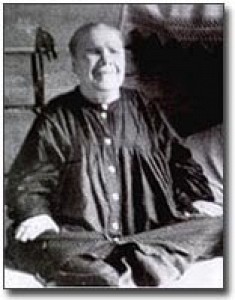BLESSED ST. MATRONA OF MOSCOW
(1881 - 1952)
Feast Day: May 2nd ✞ Glorified: 1999 & 2004
Click here for 2-page PDF file.
The Blessed Eldress, St. Matrona the Blind of Moscow, was born blind into a poor rural peasant family, and at the age of 17 she lost the use of her legs due to paralysis; she possessed neither higher education, material wealth, nor high social status, and was dependent on the kindness of others for her daily living. Thus, in many ways she is almost a polar opposite of three other 20th century holy women who are portrayed on the walls of St. Innocent Orthodox Church: Grand Duchess St. Elizabeth Romanova, St. Maria of Paris and Mother Gavrilia of Athens, who were born into wealthy aristocratic families, received excellent education, and were pioneers in their pastoral-deaconal ministry to the poor, sick and suffering; each of them were tonsured nuns later in life; two of them had been married, and also were martyred. But in some vital ways, Blessed Matrona is very similar to the other three holy women: all four of them died to themselves in order to live totally for Christ, and to serve Him by loving and serving needy, suffering people, according to the gifts God gave to each, in the place God appointed for each of them to serve Him. All four of them had loving, compassionate hearts, trusted totally in God, and did not complain about their misfortunes or the heavy crosses they were called upon to bear.
But Blessed Matrona’s sanctity and influence are also very different. Although never tonsured a nun, Blessed Matrona lived a monastic life of strict asceticism, constantly united with God in prayer. She couldn’t go to the people, and so the people came to her—and still are coming in droves. Since her childhood, when God’s gifts of divine wisdom, clairvoyance, healing, spiritual insight and discernment became apparent to others, people started coming to her for help and healing. After moving to Moscow in 1925, people increasingly came to her for her spiritual help, as to an Eldress. The tradition of “Eldership” is very strong in Russia—to this day. Just as in the 19th century people of all classes and backgrounds frequently went to elders—such as St. Seraphim of Sarov (+1833), and the Optina Elders—so they went to Blessed Matrona in the 20th and 21st centuries. And the most miraculous thing is that people are still flocking to her—now, more than ever. As Blessed Mother Xenia of St. Petersburg (+c.1803) is, and has been for two centuries, the protectress and helper of those in St. Petersburg, so Blessed Mother Matrona of Moscow is now the protectress and helper of those in Moscow, and throughout the world. On the day of her repose, May 2, 1952, “Matronushka,” as she is affectionately called, gave spiritual direction for all people after her repose: “Come close, all of you, and tell me your troubles as though I were alive! I will see you; I will hear you; and I will come to your aid.” People today, from all over Russia and the world, are doing precisely this, and countless miracles continue to happen to this very day. On May 1, 1998, the Blessed Eldress’ relics were transferred from the Danilov Monastery to the Pokrov Women’s Monastery in central Moscow. One year later, exactly 47 years after her repose, she was glorified as a local Moscow saint. In 2004, she was universally glorified for the whole Church. Now the relics of the Blessed Eldress of Moscow are readily accessible for people’s veneration: people stand in line for hours in order to venerate her relics and pray to her. And she is present, and does hear, and does come to people’s aid, exactly as she had done for the 70 years of her earthly life. As in her earthly life, when no one left her without receiving the aid they sought from her, so now countless miracles continue to occur for the endless streams of people going to venerate her relics and icons at the Pokrov Monastery, and as had previously occurred between 1952 and 1998, when they had gone to her cemetery grave. Truly she is a vehicle of the Holy Spirit in people’s lives.
An example of her clairvoyance and powerful intercessory prayer is cited in a sermon delivered in February 2005 by Fr. Valery Krechetov in his church outside Moscow. He mentioned how the New Russian Confessor, St. Bishop Stefan, when he was about to be sentenced to a second ten-year term in Stalin’s concentration camps, cried out to Blessed Matrona while she was yet alive: “Matronushka! Help me in my troubles!” Shortly thereafter, he was miraculously released. Before going home, he went to find the Blessed Eldress to thank her. Upon entering the house where she lived, not seeing anyone, he called out in greeting. And the Blessed One, in response, greeted him by name. “How did you know my name?” he asked. “Why, didn’t you call me? As you can see, I heard you!” replied Eldress Matrona. As she did while still in the body, so she continues to do today.

But how does a poor, illiterate, blind and crippled peasant, living in the heart of Moscow under Communist persecution for 27 years—a person of our own times, having reposed in 1952—become such a highly venerated saint? Certainly, only by the grace of God! Indeed, she was filled with His Grace from before birth. Matrona Dimitrievna Nikonovna was born into a poor, large peasant family on November 9, 1881, in the village of Sebino, in the Tula Province, several hundred miles south of Moscow, near Kulikovo Field. Just prior to her birth, her mother had a dream of a little blind bird with a human face flying down to her and perching on her right hand. Her baby was then born with recesses where her eyes should be. When the infant Matrona was baptized, everyone present witnessed an aromatic column of wispy smoke ascend from her baptismal font up to the dome, which they correctly perceived to be an indication that she was a Chosen-One of God. From infancy she loved the icon corner, and going to her village’s Dormition Church which was nearby. In fact, from the time she could walk to the church by herself, young Matrona never missed a Divine Service. If her mother couldn’t find her at home, she knew she would be at the church.
One time, when the Blessed One was still very young, an old man came into the house and asked for a drink of water, which compassionate Matrona immediately gave him. When he left, he lightly tapped the child on the chest, making the imprint of a cross on her chest, which was visible throughout her life. The young child knew who her visitor was—that it was St. Nicholas the Wonder-Worker. When the Blessed Eldress’ relics were removed from her grave in 1998, and her incorrupt relics examined, this raised cross on her chest was still plainly visible.
As the future saint was growing up, she suffered much, enduring much cruelty at the hands of her brothers and sisters and the neighborhood children, who hit her, picked on her, hurt her. But when her beloved mother would lament, “Oh my poor unfortunate child!” Matrona would answer that she wasn’t a “poor child,” but that her two older brothers were “poor children”— for their cruelty towards her, and their general lack of faith and compassion.
Signs of the spiritual gifts from God of clairvoyance and wisdom manifested themselves very early in the humble and meek child chosen-by-God. Not only did people listen to what she said, but they started coming to the child from all over, coming with their troubles. She comforted them in their suffering, healed the sick, and wisely counseled them. Although blind physically, she received from God great powers of spiritual sight—clairvoyance, insight and foresight—which she always used to help those who came to her from near and far to find relief for their sorrows.
The future saint won the hearts of many good and faithful people. One such person, Lydia Yankova, was the daughter of a local nobleman. She loved to go on pilgrimage to holy places, and would bring the young Matrona with her to visit holy monasteries and to talk with the elders. Around the mid-1890's, when the blessed one was about 14, Lydia took her to St. Petersburg. They were among the thousands who daily went to worship at St. Andrew’s Church on the island of Kronstadt, and to receive the blessing of the saintly ‘Batiushka of all Russia,’ Father John Sergiev (+1908). Imagine the astonishment of everybody, when Father John of Kronstadt cried out: “Matrona, Matrona, come here! Everyone make way, and bring her here to me! Here is the one who will take my place: the eighth pillar of Russia!” Of course no one knew what he meant at the time, but indeed, St. John of Kronstadt correctly discerned the future role of the Blessed One in helping the faithful Russian people to cope during the years of persecution by the Communists, and now, as the Orthodox Church is revitalized and people’s faith resurrected.
At the age of seventeen, Matrona lost the use of her legs, which became paralyzed. But she never complained nor felt sorry for herself, but accepted everything that happened to her with patience, and trust in God’s care. Blind, and no longer able to walk, she had to rely on the mercy, good-will and kindness of others for her daily sustenance. And the Lord always provided the means of life for this, His Chosen-One. God alone knows how she suffered. But she turned her suffering into a means of dying to herself and living totally for God—through faith, humility, non-complaining long-suffering, fortitude, and acceptance of God’s will.
Having the divine gift of foresight, Matrona foresaw what was to happen to Russia as a result of the Communist Revolution, and she tried to guide people accordingly. She was 36 when the Revolution erupted. For another seven years she continued to live in her village of Sebino. Finally, in 1925, she had to move to Moscow, because of hostility by her brothers, and because her presence in Sebino brought danger to the village, due to her very public opposition to the Communists. For 27 years she lived in Moscow, much of that time having to constantly move from place to place, as the Communists sought to arrest her. One shack where she lived was so cold, that her hair would freeze to the wall by her bed. Most of the time she lived with different faithful benefactors, along with an attendant. Several times her benefactors were arrested, but the Lord preserved His Chosen-One from arrest. She customarily spent her time sitting cross-legged on her bed, peacefully united with God in continual prayer. She ate little and slept little. Her faithful benefactors and attendants brought suffering people to the Blessed Eldress, and whatever their troubles, she helped them—by healing them, counseling and consoling them, or, through her powerful intercessory prayers, achieving miracles, such as in the case of Bishop Stefan, mentioned above. She compassionately received everyone who came to her, knew precisely what each person needed, and what to say and do for each person who appealed to her for help, either in person or from a distance. One idyllic time she lived with a wonderful family, all in one large room, for seven years, from 1942-49. The daughter recalled later that “Matushka [Matrona]’s love and her stillness enveloped our souls. Our home was full of holiness, joy, peaceful rest, and a grace-filled warmth. The war [WWII] came, and we lived like we were in heaven.” Matronushka never complained of her suffering, and was always loving, peaceful and patient, by which she conquered all of her own illnesses and suffering. She also suffered much for the torment that the Communists rained upon faithful Russia and the Church. She beseeched the people not to throw away their faith, for then disasters would visit them. She exhorted: “Pray! Beseech! Repent! The Lord will not forsake you, and He will preserve our land!”
The Blessed Eldress knew when she would repose. A few days prior, she received Holy Unction, Confession and Communion. She gathered her close friends together and gave departing counsel. Although she came from simple peasant people, her funeral showed how social class means nothing in the spiritual realm. Crowds of people came to her funeral: simple laborers and scholarly monks from the Trinity-Sergiev Lavra, priests and military officers; she was buried in the cemetery of the Danilov Monastery in Moscow. Thanks be to God that her relics now reside at the Pokrov Monastery, where Molebens and Akathists are served daily and where her relics are accessible for veneration. Blessed God-pleasing servant of God, pray to God for us!
By Sister Ioanna, St. Innocent Monastic Community, Redford, Michigan
The icon at the top was painted/written by Fr. Theodore Jurewicz, of Erie, Pennsylvania, and is located on the narthex wall at St. Innocent of Irkutsk Orthodox Church in Redford, Michigan.

